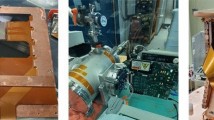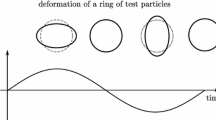Abstract
The possibility of observing diurnal variations in the count rate of dark photons using multicathode counters is considered. It is shown that with detectors placed in three mines at different latitudes, Pyhäsalmi (Finland), BNO (Russia), and INO (India), and with measurements performed at three different detector orientations, a set of data can be obtained that is complete enough to allow determining the dark photon field vector. The results of the latest measurements with counters we developed are reported.








Similar content being viewed by others
REFERENCES
E. Aprile et al. (XENON Collab.), “Dark matter search results from a one ton-year exposure of XENON1T,” Phys. Rev. Lett. 121, 111302 (2018).
D. S. Akerib et al. (LUX Collab.), “Results from a search for dark matter in the complete LUX exposure,” Phys. Rev. Lett. 118, 021303 (2017).
P. Agnes et al. (DarkSide Collab.), “DarkSide-50 532-day dark matter search with low-radioactivity argon,” Phys. Rev. D 98, 102006 (2018).
L. B. Okun, “Limits on electrodynamics: paraphotons?” J. Exp. Theor. Phys. 56, 502 (1982).
B. Holdom, “Two U(1)’s and ϵ charge shifts,” Phys. Lett. B 166, 196 (1986).
S. N. Gninenko, “Search for MeV dark photons in a light-shining-through-walls experiment at CERN,” Phys. Rev. D. 89, 075008 (2014).
D. Banerjee et al. (NA64 Collab.), “Improved limits on a hypothetical X(16.7) boson and a dark photon decaying into e + e − pairs,” Phys. Rev. D 101, 071101(R) (2020).
D. Horns, J. Jaeckel, A. Lindner, A. Lobanov, J. Redondo, and A. Ringwald, “Searching for WISPy cold dark matter with a dish antenna,” J. Cosmol. Astropart. Phys. 04, 016 (2013).
A. Kopylov, I. Orekhov, and V. Petukhov, “A Multi-cathode counter in a single-electron counting mode,” Nucl. Instrum. Methods Phys. Res., Sect. A 910, 164 (2018);
A. Kopylov, I. Orekhov, and V. Petukhov, “Method of search for hidden photons of cold dark matter using a multi-cathode counter, Phys. At. Nucl. 82, 1317 (2019).
R.B. Cairns, and J.A.R. Samson, “Metal photocathodes as secondary standards for absolute intensity measurements in the vacuum ultraviolet,” J. Opt. Soc. Am. 56, 1568 (1966).
I. M. Bloch, R. Essig, K. Tobioka, T. Volansky, and Yu Tien-Tien, “Searching for dark absorption with direct detection experiments,” J. High Energy Phys. 06, 87 (2017).
J. C. Stover, Optical Scattering: Measurement and Analysis, 2nd ed. (SPIE Press, 1995).
M. Settimo (DAMIC and DAMIC-M Collab.), “Search for low-mass dark matter with the DAMIC experiment.” arXiv:2003.09497.
J. Suzuki, T. Horie, Y. Inoue, and M. Minowa, “Experimental search for hidden photon CDM in the eV mass range with a dish antenna,” J. Cosmol. Astropart. Phys. 09, 042 (2015).
A. Kopylov, I. Orekhov, and V. Petukhov, “Results from a hidden photon dark matter search using a multi-cathode counter,” J. Cosmol. Astropart. Phys. 07, 008 (2019).
A. Andrianavalomahefa et al. (FUNK Experiment Collab.), “Limits from the Funk experiment on the mixing strength of hidden-photon dark matter in the visible and near-ultraviolet wavelength range.” arXiv: 2003.13144.
ACKNOWLEDGMENTS
The authors are grateful to G.I. Rubtsov for helpful discussions.
Funding
The work was supported within the framework of the INR Basic Research program.
Author information
Authors and Affiliations
Corresponding author
Additional information
Translated by M. Potapov
Rights and permissions
About this article
Cite this article
Kopylov, A.V., Orekhov, I.V. & Petukhov, V.V. On the Possibility of Observing Diurnal Variations in the Count Rate of Dark Photons Using Multicathode Counters. Phys. Part. Nuclei 52, 31–38 (2021). https://doi.org/10.1134/S1063779621010032
Received:
Revised:
Accepted:
Published:
Issue Date:
DOI: https://doi.org/10.1134/S1063779621010032




